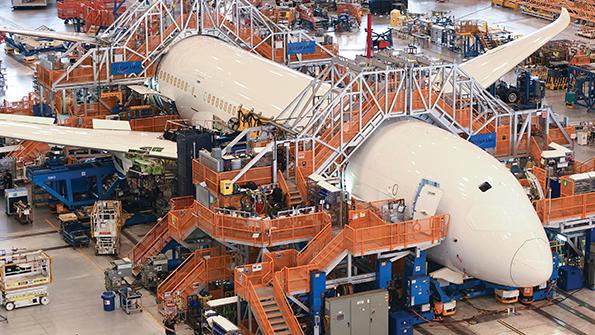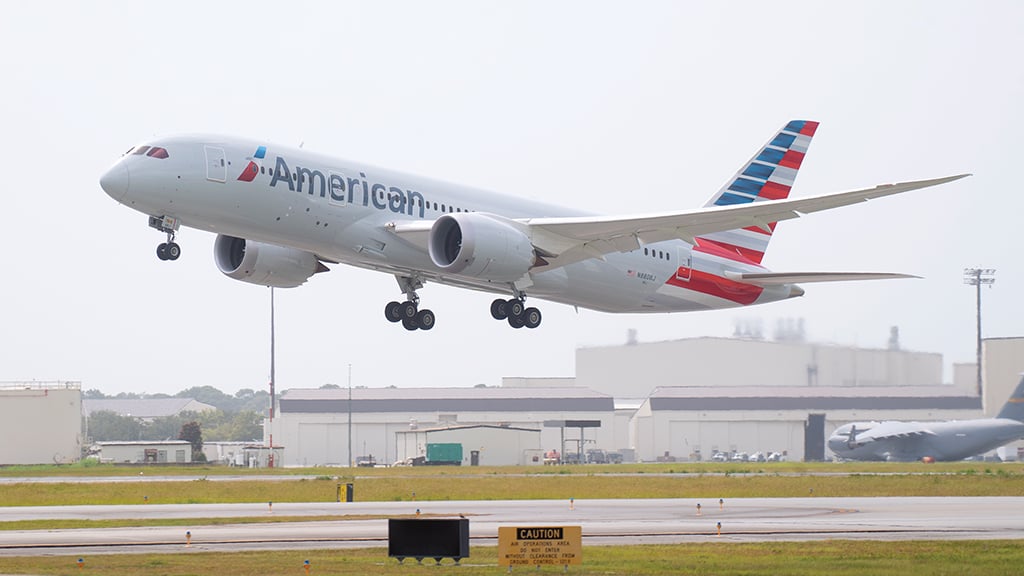
Boeing is working to align more closely 787 program design, engineering and production to head off quality problems.
Boeing’s processes for ensuring its aircraft are consistently built to company specifications are undergoing a major revamp—due in large part to lessons learned from 787 production-quality problems that halted deliveries for more than a year.
The company’s review of how 787s are built extended into a deep look at its quality management system (QMS) (AW&ST Dec. 6-19, 2021, p. 14). To no one’s surprise, the company discovered the need for improvements—both internally and at many suppliers—at almost every step between design and final production. Among the outcomes: key changes including a more rigorous, gated process to tackle risk areas in technology, design and build.
Underpinning the changes are a set of systematic enhancements to address an evident mismatch between engineering requirements and production capability. The new, gated process has been designed to ensure that no aspect of the engineering design is beyond the capability of the production system to complete the part or component. The result is an equal focus on design and production. In a related revelation, Boeing also decided that there needs to be a tighter integration between technology readiness levels and manufacturing readiness levels.
- OEM is revamping quality assurance and control on 787
- Changes are key to producing compliant airframes without rework
Various initiatives dubbed “stability projects” have been introduced to help improve the assembly process for some of the more troublesome areas, such as the aftmost Sections 47 and 48 and the fuselage crown. Projects include enhanced bladder cauls used to form composite structures with internal cavities or to form hollow structures with a fully tooled outer mold line. The newer cauls have been applied to the tooling of the aft fuselage around the inner mold line and, in the case of the forward areas of Sections 47 and 48, have achieved a 100% pass rate against initial requirements, sources familiar with the 787 program tell Aviation Week.
New tools are also helping ensure that the company’s exacting specifications are met. In one case, Boeing tapped a product used by front-line technicians to quickly and accurately check for smoothness along a surface. The system, referenced generically by Boeing in a recent company-produced article, is 3D-measurement specialist 8tree’s surface imperfection and damage-measurement tool, industry sources confirm to Aviation Week.
Developed specifically for aviation applications and used by some 50 operators, suppliers and maintenance providers, the tool brings precision 3D-measurement capabilities normally found in a lab environment to the shop floor. It provides quick confirmation of whether a given surface—in Boeing’s case, fuselage joins that cannot vary more than 0.005 in. over a 5-in. span—is within a defined tolerance.
The portable tool can be used as an in-process guide during assembly, and, according to Boeing, will be capable of supporting high-rate production levels when such rates return in the mid-2020s. Such aids are key to helping Boeing validate it is producing airworthy airframes without the need for costly, time-consuming rework.

Improved shimming processes for the crown and aft body sections have also been developed and, in the case of the crown areas, were introduced from Line No. 1102 onward.
As part of the overall effort to align engineering with production capability, Boeing also divided its gap management QMS effort into two phases. The initial phase, focused on current production Line Nos. 1140 through 1166, addressed compliance and conformance issues by making fixes to specific problem areas using the baseline build process. Engineering changes were also developed and implemented to restore compliance and conformance on almost 40 components—four of them in Section 41 alone—as part of this process for Phase 1. Ranging from the forward cargo door to the circumferential splices between major body sections, the vast majority of these changes are slated to be released to engineering by late 2022.
The follow-on Phase 2 effort, which is aimed at rate-capable, first-pass-quality production levels, includes a raft of fuselage composite fabrication changes to improve the surface quality of barrel sections. Other changes include a more structured control and monitoring approach to the build process, improved ergonomics to reduce the potential for safety issues from practices such as manual sanding, and better inspection techniques.
Boeing’s investigation into the quality issues also found that manufacturing process capability and inspections needed to be more fully integrated into the product design. It also determined that consistent integration, lessons learned and institutional knowledge—some of which had eroded over the years leading up to the beginning of the issues—were needed to prevent a recurrence of the problems. Design record books, which are used to record supporting data and critical decisions, are planned to form part of this process of recapitalizing the knowledge base and, according to details seen by Aviation Week, are due to be implemented by the end of 2022.
Similarly, new gap management design practices—including measurement and verification design practices introduced late in 2022—form part of the QMS improvement. As of midyear, Boeing had released 57 new structure design practices across its business. Of some 125 lessons learned from the 787, 21 are specifically related to gap management.

Boeing has also launched efforts to improve the level of standard work across the board, particularly in areas related to gap management, shimming and fit-up. Meanwhile, to keep a closer watch on process and production control, the accountability and strength of both the internal Boeing and external QMS has also been enhanced.
As part of the work to beef up its QMS accountability, Boeing discovered that technical oversight and process controls in engineering were inconsistently applied across the aircraft. To correct this shortfall, it introduced additional and improved training to deepen engineers’ knowledge of the production system and manufacturing methods. These actions ranged from increasing inspections, oversight and controls to updating processes with accountability such as design and technical reviews.
In parallel, Boeing continues to work with the FAA on a range of follow-on actions covering final safety determinations for the in-service fleet as well as design changes to eliminate some of the recent problems. These include a major redesign of the area in the splice joint and aft pressure bulkhead where Sections 47 and 48 meet—a change that is expected to be introduced by the second quarter of 2023.
How the quality issues affect the in-service fleet is not clear. Boeing underscores that there are no “immediate” safety of flight concerns but has not revealed how it is evaluating potential maintenance or service-life ramifications. The lack of a long track record on how fatigue affects large composite structures means Boeing likely will have to develop some of its own data to support any recommended actions. One former regulatory official says the most straightforward method is collecting data on specific issues during scheduled maintenance checks.
One of the biggest unanswered questions hangs over the revised airworthiness limitation (AWL) for the forward pressure bulkhead—which will reduce the number of flight cycles required before structural inspections to either 33,000 or 25,000 cycles from 44,000. Boeing is expected to submit its certification plans for the revised bulkhead AWL to the FAA sometime this month and clarifies that this effort is unrelated to the removal and replacement of forward pressure bulkheads on all yet-to-be-delivered 787s.
Reducing the forward pressure bulkhead inspection interval by either 11,000 or 19,000 cycles would not have a marked impact on the 787 fleet, data from Aviation Week’s Tracked Aircraft Utilization module suggests. The highest-cycle 787 in service is an 11-year-old Ethiopian Airlines 787-8, with 9,123 cycles as of Sept. 1. At that pace, the airframe would not reach 25,000 cycles until midway into its fourth decade of service.
In 2019, the average 787 airframe flew 598 cycles. At that pace, it would take 41 years to reach 25,000 cycles.
The 787 production quality crisis, during which Boeing delivered just 14 787s from November 2020 to July 2022 (AW&ST Aug. 29-Sept. 11, p. 29), hit as Boeing was breaking in its safety management system (SMS). Boeing began rolling out its SMS several years ago as part of a settlement agreement with the FAA and earned FAA acceptance for the program in late 2020 (AW&ST Sept. 14-27, 2020, p. 22).
While the FAA plans to mandate SMS for manufacturers, few currently have them, and the problem-reporting and analysis process common to airlines—which have used them for years—is not as familiar on the production side of the industry.
“Boeing is implementing a safety management system and encouraging their employees to bring things forward, and people aren’t necessarily all that conversant with how to handle [issues] and get a systemic fix in place,” says one former regulatory source involved in evaluating Boeing’s 787 work.
Ensuring employees buy into its SMS program is one of the key pillars of a safety-culture overhaul underway at Boeing (AW&ST May 30-June 12, p. 20). But it will take time.
“At an airline, it’s a little more straightforward,” the regulatory source says. “If you have a regulatory violation, you’re required to report it to the [FAA] within 24 hr., and then you have to come up with a fix. In manufacturing and production, that’s a newer concept.”







Comments